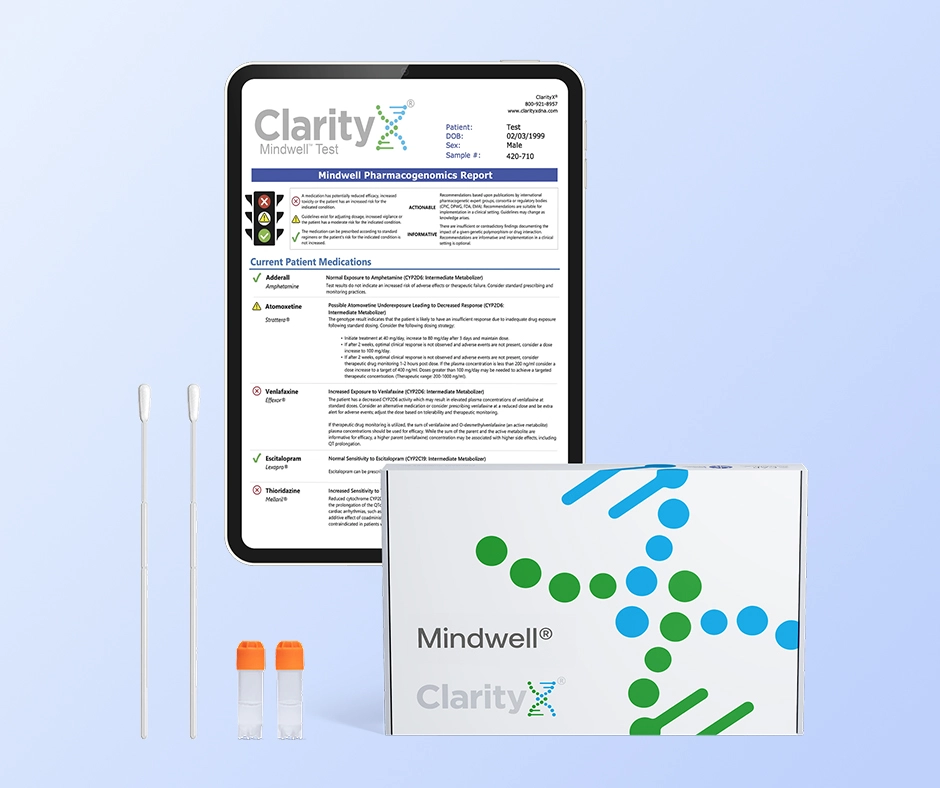The medication selection process can be arduous, especially for those who do not have experience taking psychiatric medication. While it is standard practice to accept the medication you are prescribed by your physician, these days people are becoming more discerning about what they put into their bodies and how medications may interact with their individual composition. Genetic testing for medication provides a valuable tool for helping determine which medication could be right for you. There are a myriad of genetic factors that impact how medications will interact with our chemical makeup and consequently our brains and bodies. If you are evaluating whether one antidepressant or another is better for you, such as Celexa vs Lexapro, genetic testing from ClarityX may be able to help.
Before you proceed, it is important to understand the nuances between Celexa and Lexapro. Learning about the differences between these two antidepressants may help you make a more informed decision when speaking with your healthcare professional about medication options for depression.
Celexa Vs Lexapro
Depression is a common condition that affects over 17 million Americans.1 Characterized by consistent and sometimes extreme feelings of sadness, depression can escalate to the point of impacting both mental and physical health. Some healthcare providers prescribe antidepressant medications to help reduce the symptoms of depression.
There are many forms of antidepressants, two of which are Celexa and Lexapro. Evaluating Celexa vs Lexapro and comparing the two against one another may help you determine which antidepressant is best suited for you. Genetic testing for antidepressants may also help.
Celexa Vs Lexapro: What are They?
Celexa and Lexapro are antidepressants known as selective serotonin reuptake inhibitors (SSRIs), meaning they increase the amount of serotonin in the brain. Serotonin is a chemical messenger that transports signals between neurons and affects mood, emotions, digestion, and sleep. By blocking neurons from reabsorbing serotonin, SSRIs may increase the amount of serotonin that remains in the brain by 60-80%, which in turn may help improve mood and happiness levels.
What is Celexa?
Citalopram (Celexa) is an antidepressant medication that has been approved as a treatment option for adults with major depressive disorder (MDD). Celexa has not been approved for use in children. Celexa may also be prescribed for “off-label” use for obsessive compulsive disorder (OCD), generalized anxiety disorder, panic disorder, social anxiety disorder (also known as social phobia), posttraumatic stress disorder (PTSD), binge eating disorder, and premenstrual dysphoric disorder (PMDD).
Celexa is the brand name for citalopram. This drug is also available in generic form. Celexa works by helping restore the balance of certain natural substances (i.e., serotonin) in the brain. By doing so, Celexa may help improve energy levels, sleep, and appetite in conjunction with managing symptoms related to depression.
What is Lexapro?
Lexapro is the branded version of escitalopram, an antidepressant approved for adults with major depressive disorder (MDD) and generalized anxiety disorder. Lexapro is not approved for use in pediatric patients under 12 years old. Off-label uses for Lexapro include binge eating disorder, body dysmorphic disorder, bulimia nervosa, obsessive-compulsive disorder, panic disorder, posttraumatic stress disorder, (PTSD) premature ejaculation, premenstrual dysphoric disorder (PMDD), and vasomotor symptoms associated with menopause.
Celexa vs Lexapro: Common Side Effects
Introducing any medication into your routine may be accompanied by a set of side effects. Certain side effects for antidepressants are more common than others. In general, most side effects subside within 1- 4 weeks of taking a new medication.
Common Side Effects with Celexa
Some individuals who take Celexa may experience the following side effects:
- Dry mouth
- Sweating
- Blurred vision
- Changes in appetite (both increase and decrease)
- Sleepiness and fatigue
- Increased heart rate
- Nausea
- Diarrhea
Please note that this is not a complete list of possible side effects. Some individuals may experience side effects other than those listed above. If you experience these or if your side effects are severe, please contact your doctor or pharmacist right away.
Common Side Effects with Lexapro
Taking Lexapro may come with the following side effects:
- Dry mouth
- Dizziness
- Heartburn
- Sleepiness and fatigue
- Ringing in the ears
- Constipation
- Ejaculatory disorders
- Nausea
- Changes in weight
- Changes in libido
Some people have trouble sleeping if they take Lexapro too late in the day. Regardless of the time of day you choose to take your antidepressants, it is important to keep it consistent and adhere to a schedule. Both Lexapro and Celexa may be taken with or without food.
Celexa vs Lexapro: Dosage and Forms
Your doctor will prescribe a dose of either Celexa or Lexapro based on your medical condition, your response to previous treatment methods, your age, lab tests, other medications you may be taking, and a variety of other factors. Always take your antidepressant exactly as prescribed.
Celexa Dosage
Celexa may be taken with or without food but always as prescribed by your healthcare provider. This drug is available in tablet form and as an oral solution in the generic version of citalopram. The oral solution is available in a 10 mg/5mL strength. The tablet form of Celexa is available in 10 mg, 20 mg, and 40 mg tablets, as well as oral disintegrating tablets.2 Most adults start on 20 mg per day with physicians adjusting the dosage as needed.3
Lexapro Dosage
Lexapro is available as both an oral solution and in tablet form. The generic form of Lexapro, escitalopram, is available as an orally disintegrating tablet. The oral solution of Lexapro comes in a 5 mg/5mL strength. The tablet form of Lexapro comes in strengths of 5 mg, 10 mg, and 20 mg tablets. Most healthcare providers start adults on 10 mg/day and may increase to 20 mg/day as needed.4
Celexa vs Lexapro: Drug Interactions
Celexa and Lexapro may have negative interactions with other drugs. It is best to avoid taking antiplatelet drugs like clopidogrel, NSAIDs (ibuprofen, naproxen, and aspirin), and blood thinners (warfarin) with Celexa or Lexapro as the combination may increase the risk of serious bleeding and bruising.
Additionally, it is not advised to combine Celexa or Lexapro with monoamine oxidase inhibitors (MAOIs) as doing so could cause serotonin syndrome.
Celexa vs Lexapro: How Long Does It Take to Start Working?
Neither Celexa nor Lexapro are immediate-acting drugs. As with most SSRIs and serotonin-norepinephrine reuptake inhibitors (SNRIs), these antidepressants take time to start working. While some people may start to show signs of improvement in sleep, energy, and appetite within 1-2 weeks, a noticeable difference in mood and depression may take between 2-6 weeks to present itself. While you may experience side effects without mood improvement during this initial time, it is still important to continue taking your medication as prescribed by your doctor.
Can I Take Celexa and Lexapro Together?
It is not recommended to take Celexa and Lexapro together. These two antidepressants have a chemical structure that is so similar that taking the two together could exacerbate side effects and result in dangerously high levels of serotonin collecting in the body, a condition known as serotonin syndrome.
Celexa vs Lexapro: Which One Should I Take?
The similar chemical structures of Celexa and Lexapro make these two antidepressants almost identical. Still, they are not the same. There are certain reasons some people respond better to Celexa vs Lexapro and vice versa. The availability of these drugs in oral liquid solution, tablet, and disintegrating tablet form may influence your and your doctor’s decision to take one over the other.
Additional considerations are the drugs’ chemical makeups and how these will interact with your own chemical makeup. Citalopram (Celexa) is a combination of two stereo-isomers: R-citalopram and S-citalopram. Stereo isomers have the same chemical formula as each other with a different arrangement of atoms. Escitalopram (Lexapro) contains just one isomer, which is S-citalopram.
Some people find Lexapro to be more effective and tolerable than Celexa in the treatment of depression. As for side effects, individuals have reported that Lexapro is more likely to cause sleep problems and taste disturbances than Celexa.
Another consideration is medical history. Patients with pre-existing heart conditions such as bradycardia and congenital long QT syndrome, low potassium or magnesium levels, those who recently had MI, or those with uncompensated heart failure are not advised to take Celexa.5 Please consult a trusted healthcare professional before making any decisions about your medication.
Celexa vs Lexapro: Similarities and Differences
Pharmacogenomic (PGx) Testing for Antidepressants
It used to be that the only way to figure out which antidepressant medication was right for you was through trial and error. Now there’s a better way. Pharmacogenomic (PGx) testing reduces the guesswork by immediately identifying which drug can work better for you based on your unique genetics. In addition to helping you decide between medications, it may also help you and your physician select the optimal dosages.
PGx testing works by examining the genetic variations in enzymes in the body that metabolize (i.e., either eliminate or activate) drugs. Testing will reveal how efficiently you break down certain drugs, which will indicate which medications will be most effective for you.
ClarityX: DNA Testing for Medication
ClarityX examines DNA to provide patients with detailed reports on how they may react to taking certain drugs. We look for variations with the cytochrome P450 enzymes (which metabolize over 70% of drugs), including the enzymes CYP2C19 and CYP2D6 that are responsible for how you may react to Celexa and Lexapro. ClarityX offers two testing options with our pharmacogenetic testing:
- Mindwell test: This focuses on treatments for mental health conditions that include but are not limited to depression, anxiety, ADHD, OCD, and more.
- Max Rx test: This covers 31 therapeutic areas to test how an individual may respond to more than 265 medications.
Both the Mindwell and Max Rx tests may help determine how you will respond to Celexa vs Lexapro. This could help you and your healthcare provider make more informed decisions about your treatment plan. Click here to learn more.
Compare medications reported in ClarityX
1https://www.dbsalliance.org/education/depression/statistics/
2https://reference.medscape.com/drug/celexa-citalopram-342958
4https://reference.medscape.com/drug/lexapro-escitalopram-342961
5https://www.drugs.com/medical-answers/difference-between-celexa-lexapro-3508736/





